
The EL-NIKKOR 50mm f/2.8. The "EL" in the name stands for "enlarge."
Silver halide photography involves first shooting an image and then producing a finished print by means of a sequence of darkroom processes consisting of development, printing and enlargement. The photographic enlargers that are used for this darkroom work are equipped with enlargement lenses, which project an enlarged version of the image on the film onto photographic paper.
The EL-NIKKOR 50mm f/2.8 is an enlargement lens which was released in 1957. Although this enlargement lens has undergone numerous changes in the intervening years, Tochigi Nikon Corporation, a member of the Nikon Group, continues to manufacture and sell it to this day as an industrial lens in the form of the Nikon Rayfact IL50mm.
What is an enlargement lens?
A photographic enlarger is an enlarging projection device structured as shown in the diagram. The lens used in an enlarger is known as an enlargement lens. If the lens cannot project a faithful enlargement of the image recorded on the film onto photographic paper, it cannot be called a superior "enlargement lens." For this reason, the EL-NIKKOR 50mm f/2.8 boasts the following features.
- In order to accurately project the minute detail recorded on the film onto the photographic paper, it has a resolution superior to that of contemporary photographic lenses.
- It rigorously corrects for various aberrations in particular, almost completely correcting for distortion right to the edges of the image.
- The trend at the time was for black-and-white photography. General monochrome photographic paper is exposed to near-ultra-violet light with a wavelength of 380 nm. For this reason, the lens corrects aberration in the near-ultra-violet spectrum as well as for visible light.
- With a focal length of 50 mm and a maximum aperture of f/2.8, the lens was the largest of all the enlargement lenses on sale at the time. The projected image is brighter and enables focusing to be carried out quickly and accurately.
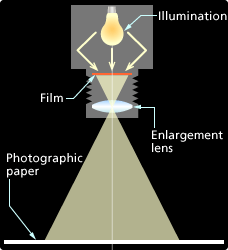
The principle of the photographic enlarger

Nikon's RA-350 photographic enlarger, only sold in Japan (image from 1979 brochure)
An outstanding proprietary optical system

The EL-NIKKOR 5cm f/2.8. On the initial lenses, the focal length was shown in centimeters.
With its four-group, six-element structure, the EL-NIKKOR 50mm f/2.8 was highly regarded. During development of the lens, a German optical manufacturer secured the patent for its basic design. Nikon (formerly Nippon Kogaku K.K.) was forced to incorporate methods that did not violate this patent into its design. There were numerous restrictions to overcome before Nikon could complete its optical system.
The company history book "Forty Years of Nippon Kogaku K. K." contains the phrase "In order to eliminate disparities in capability between the different enlargement lenses on the market..." The EL-NIKKOR 50mm f/2.8 was launched as a strategic product equipped with a newly developed optical system. It outperformed many rival lenses—including those made in Germany.
Evolution to the N-type lens

The EL-NIKKOR 50mm f/2.8N. Stylish exterior design and improved operation
An improved version of the EL-NIKKOR 50mm f/2.8, the EL-NIKKOR 50mm f/2.8N was launched in 1979. An 'N' was added to the name to denote the new type.
With improved resolution at the edges of the image and less reduction in light intensity, both of which were due to the new optical system, this model represented a considerable improvement. With the adoption of multi-coating, it also produced much clearer, higher-contrast images.
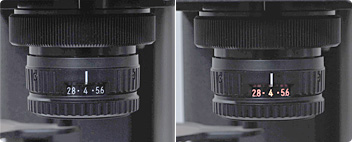
The transmissive aperture display illuminates the numerical aperture values using the enlager's light source. The light is off in the left image and on in the right.
In addition, the transmissive aperture display was a welcome convenience in the darkroom. Resin components were used on the outside of the lens, adding a stylish touch to the appearance.
With its high level of optical performance and ease of use, the EL-NIKKOR 50mm f/2.8 became the standard enlargement lens.
From photographic use to industrial use
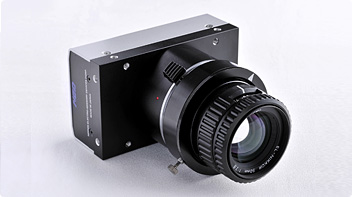
An industrial CCD camera equipped with an EL-NIKKOR 50mm f/2.8N lens.
During the black-and-white photography era, many amateur photographers installed darkrooms in their homes. In the 1970s color film became popular, which proved difficult to process in the home darkroom. This led to a decline in demand for enlargement lenses. Then, with the subsequent rise of the digital camera in the 1990s, demand for enlargement lenses dropped dramatically. In 2006, Nikon announced that they were ceasing sales of all types of enlargement lens.
After this announcement, sales outlets witnessed a flood of orders for enlargement lenses, almost all of them from companies dealing in industrial CCD cameras. From this , it became clear that there was a certain demand for enlargement lenses.
Industrial CCD cameras are used for purposes such as monitoring production lines. For example, when CCD cameras monitor an automatic packaging process, they photograph products moving on the production line and the resulting images are used to assess whether or not the products have been properly packaged. In the production process for electronic circuits, images shot with industrial CCD cameras are used to assess whether electronic components have been properly mounted in their prescribed positions.
Enlargement lenses, which faithfully project film images, are able to accurately photograph the shape of an object without distortion. This characteristic is what makes enlargement lenses ideal for use in industrial CCD cameras.
Revival as an industrial lens
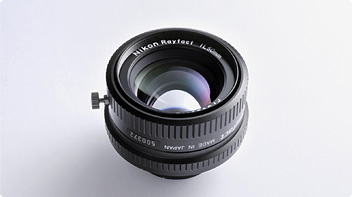
The Nikon Rayfact IL50mm. The Nikon Rayfact is Tochigi Nikon Corporation's own brand. The "IL" stands for "industry lens."

Tochigi Nikon Corporation's three-model Nikon Rayfact IL series consists of 40mm, 50mm, and 63mm lenses.
With sales being ended, production of the EL-NIKKOR 50mm f/2.8N was also scheduled to finish.
When manufacture of a particular product ends, the skills associated with that product are lost. After it became apparent that there was new demand for the lens for use in industry, Tochigi Nikon Corporation decided to continue production. This also meant that decades-long Nikon skills would survive.
It was impossible to manufacture and sell enlargement lenses as a consumer product. Thus, it was decided to continue production by containing costs (by restricting sales to the industrial arena) and reviewing pricing.
In 2007, Tochigi Nikon Corporation launched the Nikon Rayfact IL series of low-magnification industrial lenses. This consists of three different models of enlargement lens, including the EL-NIKKOR 50mm f/2.8N. The EL-NIKKOR 50mm f/2.8N was resurrected as the Nikon Rayfact IL50mm.
Used in a planetarium projecting images of 10 million stars
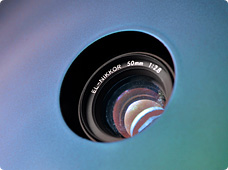
EL-NIKKOR 50mm f/2.8N lens adapted for the MEGASTAR-II cosmos.
The MEGASTAR-II cosmos planetarium at the National Museum of Emerging Science and Innovation in Koto-ku, Tokyo, was manufactured by Ohira Tech Ltd. of Yokohama, Kanagawa Prefecture. With the ability to project images of 10 million fixed stars, it is regarded as outperforming conventional planetariums by a factor of hundreds.
Using the same mechanism as an enlarger, the MEGASTAR-II cosmos uses lenses to project fixed stars shown on a plate onto a dome-shaped screen. The smallest of the fixed stars on the plate is 0.7 micrometers in diameter. A set of 32 EL-NIKKOR 50mm f/2.8N lenses serves as the projection lenses for the MEGASTAR-II cosmos.
Takayuki Ohira, a director of Ohira Tech Ltd. who developed the MEGASTAR-II cosmos, described how in the course of pursuing photography as a hobby he had witnessed at first hand the outstanding performance of the EL-NIKKOR 50mm f/2.8N, when using it in the darkroom. He cited this as one reason for adopting the lens on the MEGASTAR-II cosmos. This also attests to the lens's high level of optical performance.
QCD—the key to long-selling products
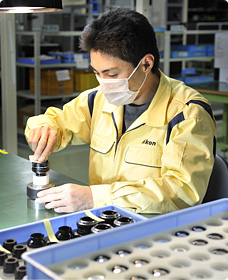
Nikon Rayfact IL lenses are meticulously assembled one by one.
The optical performance of the Nikon Rayfact IL50mm is the same as that of the EL-NIKKOR 50mm f/2.8N. However, the Nikon Rayfact IL50mm has been upgraded to an industrial lens by means of refinements such as metal external components to make it more durable and an aperture locking screw to prevent erroneous operation. Tochigi Nikon Corporation is also increasing the options available so as to meet industrial requirements—for example by selling mount adaptors for compatibility with various kind of industrial cameras and component lenses for installation in users' own machinery.
Not only does Nikon manufacture products with outstanding optical performance, the company has also maintained consistent quality, reasonable cost and reliable delivery—the so-called QCD—for over 50 years. Half a century of sales of this lens is proof that the company continues to meet user expectations even after usage of a product has changed.
The long-selling EL-NIKKOR 50mm f/2.8 survives to this day, having evolved into the EL-NIKKOR 50mm f/2.8N and then into the Nikon Rayfact IL50mm.
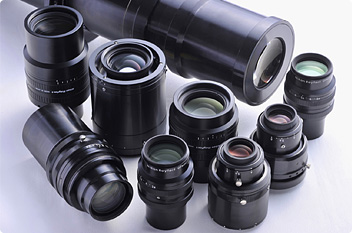
The Nikon Rayfact Series —Tochigi Nikon Corporation's series of industrial lenses. Some 20 different models are currently on sale.
Compiled with Ohira Tech Ltd. and the National Museum of Emerging Science and Innovation


